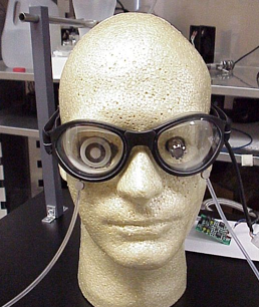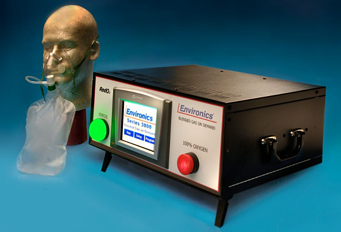Hypoxia-Related Research Applications

Environics units are a powerful tool in hypoxia related research. Scientists have successfully used the ROBD2 (Licensed from U.S. Navy under U.S. Patent Application No. 10/959.764) as well as custom Blended Gas On Demand systems (such as the ReDO2) to examine hypoxia itself as well as how placing someone in a hypoxic state could be a useful diagnostic tool clinically.
To see some recent research topics that have appeared in peer-reviewed publications, including a recent study entitled, "Uncovering Latent Deficits Due to Mild Traumatic Brain Injury by Using Normobaric Hypoxia Stress" and a review of the potential use of the ROBD2 to evaluate the need for supplmental oxygen in flight for at risk commercial plane passengers, see our research applications page.
Click hereAnother customized variation, the RODD, was designed to determine if fighter pilots could fly shortly after Lasik eye surgery. Using a variable oxygen concentration, testing was done with mannikins with one eye socket containing an O2 sensor and the other housing a hygrometer probe (see image). In addition to testing reduced oxygen, the system had a humidifier to test subjects with and without humidity.
The systems enables the operator to adjust the delivered oxygen content from 21% oxygen down to 4.4% or anywhere within that range. The system has an integrated pulse oximeter and oxygen analyzer as well as an emergency oxygen dump switch for delivery of 100% oxygen. Customization of our systems is always possible.

Flexibility: Environics’ systems automatically blend and dilute gases to generate precise oxygen concentrations. The oxygen level can be varied in response to your commands anwhere from 21% down to 4.4%.

Accuracy: Our gas mixing technology is based on very precise control of thermal mass flow controllers. Normally, thermal mass flow controllers offer an accuracy +/- 1% of full-scale flow. However, when combined with Environics computerization and calibration, this accuracy specification is improved to +/- 1% of setpoint. The Full-scale error vs. Setpoint error document shows the 10x improvement in accuracy of a thermal mass flow controller when using Environics controlling technology.
Repeatability: Our systems have a repeatability of +/-0.05% of full scale.
Custom Systems: We have thousands of systems in the field and have developed an extensive library of applications and solutions to meet our customers' needs. Other optional features, such as audible/visual alarms, are available to best suit your needs. Contact us for more information.

